Whisky bluff to whisky buff: everything you need to know about sherry cask whisky
Uncategorized
If you’ve ever read the Whisky Foundation blog, you’ll know that we’re huge fans of sherry cask whisky.
We’ve written articles about our favourite sherry cask whiskies, have a huge selection available to purchase and – best of all – some of us like to end the day with a sherry cask whisky.
And, according to a blind study, it’s not just Whisky Foundation that prefers a dram with a hint of sherry.
In fact, in a blind test of bona fide whisky buffs, whiskies that had been aged in a sherry cask were consistently ranked higher than their non-sherry-cask counterparts.
Why?
The time spent aging in a sherry cask seems to bring out the very best in the whisky. It makes them richer, gives them a much deeper and fuller flavour and adds a nice fruitiness to the nose and palate.
But why sherry casks?
Buckle up, here comes a quick history lesson.
It’s important to understand that – although sherry cask whiskies are very popular at the moment – sherry casks have been used to age whisky for centuries, for many different reasons.
The first reason?
The Scots used to absolutely love sherry. The first recorded consumption of sherry was in Edinburgh in the mid-16th Century (1548, to be precise), but it took a few centuries to properly catch on. By the 18th Century, it was the drink du jour. The Scottish trendsetters – the 18th Century Beckhams and Kardashians – used to love a good sherry punch.
On top of that, according to ScotchWhisky.com, patriotism played a large role in the popularity of sherry:
There was also an element of patriotism involved, with many Scots either working for or owning Sherry houses: Arthur Gordon established Bodegas Gordon, then a distant relative William joined his uncle to found Duff-Gordon, while George Sandeman’s Port and Sherry interests were handled in Scotland by his relative Thomas from his base in Perth.
Finally, the third reason was simple logistics. (This is the most boring reason, sorry.) In Scotland, making casks from oak wasn’t really an option, so the distilleries had to use what was around them: docks. The sherry, wine and rum casks that would come into the docks were snapped up by distilleries and independent bottlers and used to age and finish whisky.
In fact, prior to prohibition, the vast majority of Scotch was finished in sherry or madeira casks from Europe.
However, after prohibition, that all changed. The US government, after a tonne of clever pressure from a Coopering Union (the people who make casks and who were going out of business) made it illegal for a bourbon cask to be used more than once.
Scottish distillers were presented with an opportunity. As the laws on sherry casks changed and the supply dropped off, there was an influx of Bourbon casks.
Does sherry cask whisky taste different?
Good question.
It does, which is part of the reason that independent bottlers, more concerned with producing incredibly whiskies than turning a profit, still finish their whiskies in sherry casks.
What makes it taste different?
In every sherry cask, there’s approximately 10 litres (17 pints if you’re British, 2.6 gallons if you’re across the pond) of sherry.
But this isn’t what causes the sherry flavour – not at all, interestingly. (Otherwise, you’d be able to just throw some sherry into your whisky, wouldn’t you?)
Instead, the sherry interacts with the oak cask and changes its compounds. These compounds then interact with the whisky to give it the sherry character. The whisky soaks in and out of the cask, taking on the flavour of the cask and the compounds that have been changed by the sherry, giving it that sweet, sherry finish.
And boy, is it something.
Don’t believe us? Try this once-in-a-lifetime sherry cask whisky:
Glenlivet 45 Year (Gordon & MacPhail, 1967)
This is one of those whiskies that words can’t do justice, but if we had to describe the experience, we’d say that the nose has a classic sherry character with hints of fruit, nuts and liquorice that carry through onto the palate where chocolate notes are introduced into the mix. Finally, the fruit warms into an almost Christmassy winter spice.
This is independent bottling at its best – an incredibly complex, impressively aged and the perfect celebration of sherry cask whisky.
It really is quite special.



